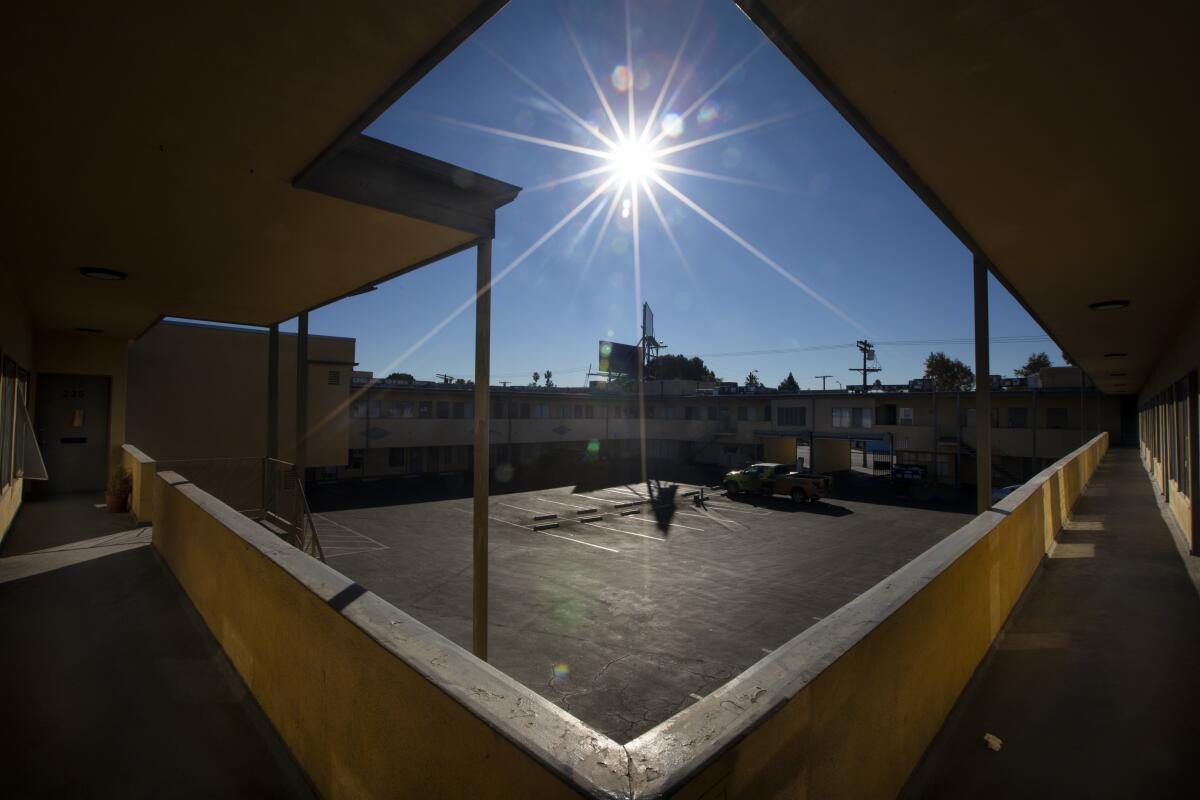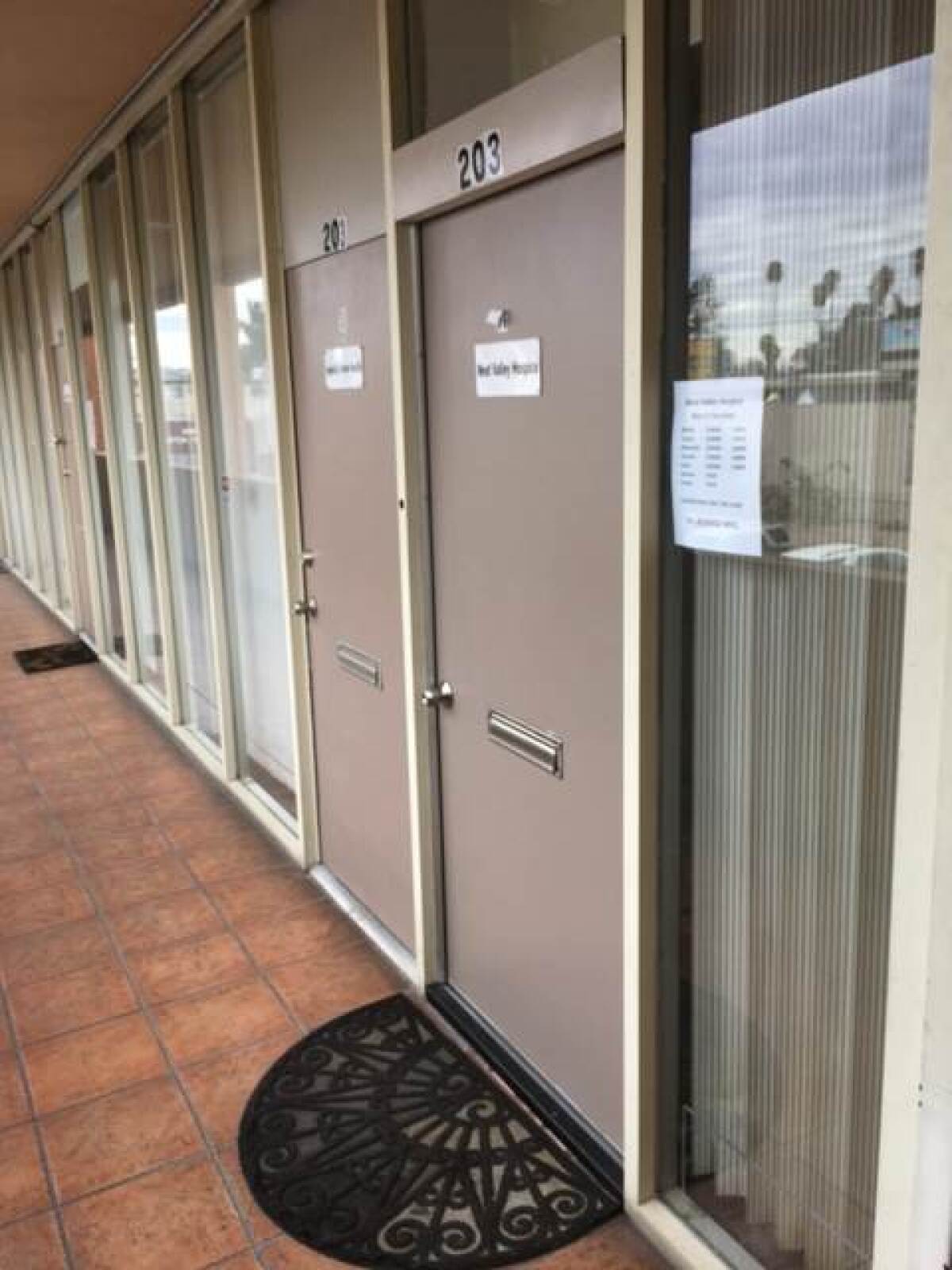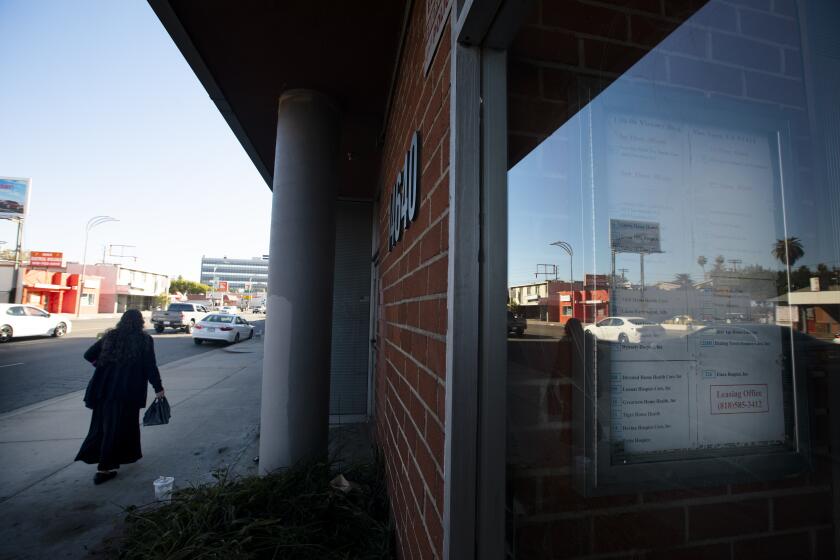Dying Californians suffer harm and neglect from an industry meant to comfort them

- Share via
Nicolas Tuparan was eating breakfast at a Pasadena nursing home when he suddenly gasped for air.
“Your father choked on eggs and oatmeal,” a nurse with Vitas Hospice Services would later tell Tuparan’s daughter, according to his family’s lawsuit. “He was very demanding and keep on telling me: feed me, feed me! So I kept on feeding him.”
Tuparan, 88, stopped breathing and fell into a coma.
The nurse said she did not perform CPR because it was against Vitas policy, even though Tuparan had explicitly requested lifesaving measures in the event of a medical emergency, the complaint alleged. Vitas attorneys did not respond to messages seeking comment.
Deprived of oxygen, Tuparan suffered severe brain damage, underwent a tracheostomy and intubation and was put on a ventilator. He died two months later.
“We have had a lot of anger and pain because my father did not die naturally,” his daughter, Lori Tuparan, said of the February 2016 ordeal. “They robbed him away from us.”
Nicolas Tuparan’s experience is the antithesis of the compassionate, comforting care that hospices promise the terminally ill.
But it is hardly unique among a group of patients who are often bedbound, cognitively impaired and heavily dependent on caregivers who sometimes fail them, with devastating results.
At a time when the U.S. population is aging and the hospice industry is booming, a Times investigation found hundreds of instances in which California patients were harmed, neglected or put at serious risk, their mistreatment sometimes exacerbated by serious gaps in government oversight.
Quality-of-care failures ran the gamut from mismanaged medications to neglected wounds that became infested with maggots. Nurses and home health aides repeatedly missed appointments or slept on the job as patients lay writhing in pain.
But even when regulators identified such failures, hospices were rarely penalized, according to a review of lawsuits, Medicare data and state licensing and inspection records spanning a decade. Violations that led to severe infections or death were addressed with little more than a promise by hospices to do better.
Hospices are regulated far less rigorously than other healthcare providers. While nursing homes and hospitals are subject to a range of potential fines and civil enforcement actions, hospice regulations do not provide for those penalties.
At the federal level, regulators rarely impose their only available sanction: cutting off Medicare funding and booting bad actors from the program. From 2014 to 2017, only 19 hospices were terminated — fewer than one half of 1% of the 4,000-plus providers then operating nationwide, according to the Government Accountability Office.
‘Hospices are so poorly regulated in California, and Medicare dollars are so lucrative, that a lot of companies are trying to cash in.’
— Michael Connors, a patient care advocate with California Advocates for Nursing Home Reform
Until 2015, Medicare mandated hospices to be inspected only once every six years. That time frame has been shortened to once every three years, but inspections remain less frequent than those required annually for nursing homes.
“Really, the enforcement is still pathetic,” said Charlene Harrington, a UC San Francisco nursing professor emeritus who formerly worked for the California Department of Public Health, which regulates hospices in the state.
“If you are only visiting every three years, you are not catching everything,” she said. “There’s no penalty, so why stop doing it? You know they’re not coming back to check on you for three years. It’s ludicrous.”
Nowhere are the problems more acute than in California, where the number of hospices quadrupled over the last decade as end-of-life care became a multibillion-dollar business dominated by profit-driven operators. Los Angeles County alone saw a sixfold increase in hospices, according to a Times analysis of federal healthcare data.
Nowhere has the hospice industry’s growth been more explosive, and its harmful side effects more evident, than in Los Angeles County.
States license and inspect hospices for the federal government, but providers may opt to choose their own overseers by hiring accreditation agencies that have the authority to “deem” them to be in compliance with federal standards.
Deemed hospices face less government scrutiny and are less transparent than others because they are not subject to inspection and recertification by state regulators, and accreditation organization inspection reports by law are not made public.
More than 80% of California hospices choose accreditation, compared with about half nationwide.
Relying on accreditation organizations to inspect large numbers of hospices that pay them creates a conflict of interest and diminishes accountability, said Michael Connors, a patient-care advocate with California Advocates for Nursing Home Reform.
“Hospices are so poorly regulated in California, and Medicare dollars are so lucrative, that a lot of companies are trying to cash in,” Connors said. “There is no meaningful regulatory oversight whatsoever in California.”
In a written response to questions about its oversight of hospices, the California Department of Public Health told The Times that it “enforces both federal and state requirements as described in state and federal law.” Asked if it favored having the authority to impose fines or other penalties, the agency said, “we decline to respond to hypothetical questions.”
The Centers for Medicare and Medicaid Services also declined to respond to specific questions but defended its oversight of hospices, citing its use of data analysis, medical review and investigations.
“Ensuring patient safety and access to quality care at hospice and all certified care facilities is paramount to CMS’ work,” it said in a statement to The Times. “The agency takes the oversight role of the Medicare hospice program seriously and is aggressively focused on reducing and eliminating fraud, waste, and abuse.”
Since the outbreak of COVID-19 earlier this year, there has been even less oversight.
In March, Medicare suspended requirements for most hospice inspections, limiting investigations to complaints and only the most serious incidents, such as those involving abuse and infection.
Mark Smith, a spokesman for the state public health agency, said it has suspended some regulatory requirements but is following Medicare guidelines and an executive order by Gov. Gavin Newsom, which require it to act on “allegations of the most serious violations impacting health and safety.”
Long before the pandemic, serious patient-care flaws had surfaced in California’s hospice system.
A July 2019 analysis by the U.S. Department of Health and Human Services Office of Inspector General found that 94% of California’s hospices had at least one serious deficiency from 2012 to 2016. The nationwide rate was 80%.
In a 2016 sampling by the inspector general, 313 hospices surveyed nationwide qualified as “poor performers” by having at least one serious deficiency or substantiated severe complaint. California led the country with 45.
The Times’ analysis of federal data shows that California also had the largest raw number of the most-serious violations, with 420 since 2008 — four times as many as states such as Texas and Georgia, which also have large numbers of hospices. Los Angeles County accounted for 43% of those, racking up 179.

The most common serious violations include missed nursing visits, state records show.
An Alzheimer’s patient living in a senior community in Riverside was scheduled for visits by a Vitas hospice nurse every Monday, Wednesday and Friday. The nurse failed to show for a 10-day stretch in 2016, allowing the patient’s open sore to fester.
“This agency failure resulted in Resident 1 not receiving adequate wound care and developing maggots … in a foot wound, requiring admission to the acute care hospital,” a state report said.
In a similar scenario, 11 missed nursing visits over two months left a patient at Innerjoy Hospice in Simi Valley hospitalized with a serious foot wound.
Even when appointments are kept, there is no guarantee of quality care.
In one San Diego case, Vitas sent a home health aide to monitor a cancer patient overnight and keep him comfortable. Twice during the night, the man’s family member was awakened by his loud moaning in pain, according to a state inspection report. Both times, she found the aide asleep and wearing earphones at the anguished man’s side.
The October 2015 incident led to a neglect finding by state investigators, who also found that the aide falsified records to hide that he had given medication to the patient several times even though he was not authorized to do so.
The aide “was counseled and no longer works for Vitas,” the company said in a corrective action plan that included re-educating employees about work rules and practices.
Another aide, working in 2015 for Hospice Spectrum Inland Empire in Rancho Cucamonga, triggered a finding by state inspectors of “immediate jeopardy” — a situation in which patients are at serious risk.
The aide told state inspectors that twice a week she had been refilling a patient’s pill box, checking her blood-sugar level with a glucometer and giving her insulin shots “in the stomach” — all tasks for which the aide was unqualified.
“This failure had the potential to adversely affect the patient’s health and safety,” an inspection report said, noting that the home health aide was terminated.
Although hospices are required to submit corrective action plans to address violations, the plans do little to prevent recurrences, according to the Health and Human Services inspector general.
“The plan is designed to address a specific circumstance; it is not designed to resolve the underlying issues that gave root to the deficiencies and may continue to cause harm to other beneficiaries,” the federal watchdog said in a report issued last year.
The inspector general recommended that the federal Centers for Medicare and Medicaid Services, or CMS, seek authority to impose fines and deny payments for care, as it does with problematic nursing homes and home health agencies.
“We urge CMS to extend these protections to hospice beneficiaries,” the inspector general said. “These beneficiaries are especially vulnerable and should be protected from harm.”
At the state level, the only fines are for improperly disclosing patient information, often through lost or stolen records. Since 2014, California has cited about a dozen such breaches.
Lax enforcement is exacerbated by a lack of transparency in reporting problems.
Choosing a reputable hospice can be a challenging task at an emotional time for families.
Licensing and inspection reports compiled by the state — sanitized of key information, such as the names of hospice employees and doctors — are available to the public and include details of violations and corrective action plans.
But inspection reports written by the accreditation agencies that oversee the vast majority of California hospices are not publicly disclosed.
At least two legislative efforts to address shortcomings had stalled in Congress in the past year, including a bipartisan bill introduced in February by U.S. Reps. Jimmy Panetta (D-Carmel Valley Village) and Tom Reed (R-N.Y.).
The bill would expand available penalties to include fines of up to $10,000 a day and suspension of Medicare payments. It also would require Medicare to post inspection results online.
The bill cleared the House Ways and Means Committee but had been derailed by the pandemic, according to a Panetta spokesperson. On Tuesday, it was incorporated into another Medicare-related bill, the BENES Act, which was approved by the House. The act now will move to the Senate for consideration.
Absent major changes in the system, consumers shopping for a hospice in their neighborhood might never know about serious problems uncovered by state and federal regulators.
Take, for example, Senior Hospice Care Inc. in Burbank.
The company was cited in August 2018 after a patient suffered extreme pain for two days “without any relief” before he died. State inspectors found that a hospice nurse failed to show the patient’s family how to safely give him morphine to alleviate his discomfort from kidney cancer, according to inspection records.
“I did not give it to him even though he was in pain. I was waiting for the nurse to come and show me how,” a family member told a state surveyor.
Regulators flagged it as an “immediate jeopardy” situation.
A representative for Senior Hospice Care did not respond to requests for comment.
With some digging, details of the 2018 incident can be found on an online database of complaint investigations compiled by the Centers for Medicare and Medicaid Services.
But there is no information about it on the Medicare compare website, which CMS promotes as a tool for consumers to gauge the quality and safety of hospices across the country. In general, the site provides scant details about complaints, inspections or specific problems identified by regulators.
Details about the 2018 violation are also nowhere to be found on Cal Health Find, the state database of healthcare facilities where consumers can search hospices by name.
“It is all very hard for the consumer to figure out,” said Harrington, the UCSF nursing professor emeritus.
Harrington tried to remedy the situation with CalQualityCare.org, a joint project of UCSF and the California Health Care Foundation that rated hospices and other facilities and provided additional information to help consumers pick good providers and avoid bad ones.
The website was supported by the foundation for more than a decade but was taken down after it lost its funding in 2016. A subsequent bid to secure state funding was unsuccessful, but Harrington said she hopes to find another revenue source and revive the website.
With little public information available to guide their choices, families seeking hospice care for their loved ones are left to their own devices.
A stroke left Joan Price severely disabled, paralyzed and unable to speak, eat, drink, dress or wash on her own.
The octogenarian lived with her daughter for seven years before signing up for services with Roze Room Hospice of the Valley in April 2016 and moving to an assisted living facility the next month, according to a lawsuit filed by the daughter, Jennifer Price.
Soon after, during a visit at the assisted living facility, Jennifer noticed that her mother’s left leg was swollen and asked a hospice nurse to assess it. The nurse refused, the lawsuit alleged, insisting that the swelling and associated pain were due to arthritis.
“Your mother is fine,” the nurse said, according to the complaint.
Price, a Simi Valley music store owner, was skeptical and took her mother home. While undressing her for bed, she discovered that her left leg had ballooned to twice the size of her right one.
She called Roze Room to send a nurse. After waiting in vain for 18 hours, she took her mother to the hospital and learned that her left femur was fractured.
Joan Price spent a week in the hospital for her broken leg.
Her daughter sued the hospice, the assisted living home and a skilled nursing facility for elder abuse, neglect and wrongful death after Price died in June 2017. All denied wrongdoing.
She also filed a complaint against Roze Room Hospice with the state public health department, which substantiated the allegations and approved the provider’s corrective action plan for improving communications and coordination of services.
Jennifer Price, who reached a confidential settlement last December, declined to comment for this article. Attorneys for Roze Room did not respond to requests for comment.
Three years after the death of Peter Craig on Oct. 24, 2017, his sisters Joyce Craig and Ellie Craig Goldstein are haunted by the memory of his final hours.
Craig, 74, a widower and accounting-firm partner who was in the end stages of cancer, had signed up with Providence TrinityCare Hospice just a few days before he died. His family needed someone “to be there to help us get through this at the end,” Joyce Craig said.
Hospice representatives enrolled Craig and gave his family a “comfort kit” with the narcotic painkiller morphine, and left a flier with a number to call when his condition deteriorated. The hospice also promised to send someone to stay at his side as he neared death, the sisters said.
The day before Craig died, his family started phoning the agency whenever his condition changed significantly, Joyce said, but calls went unanswered or were not returned.
On her brother’s final day, she said, a hospice nurse visited his home and consulted briefly with the family but had to leave for another appointment.
Instead of spending their brother’s final hours comforting him, Joyce said, she and Ellie were in the kitchen, repeatedly calling the hospice for help, as he thrashed in pain in the next room.
“How did it ever happen that I was the one who had to give him his last morphine before he died, because they didn’t come?” Ellie said. “It’s a nightmare.”
Providence TrinityCare executive director Shayna Stiles said in a statement that the nonprofit hospice “is committed to caring for terminally ill patients and supporting families during a sacred time in their lives,” but that it cannot comment on Craig’s care because of privacy laws.
“We have the utmost compassion for Peter Craig’s family and their loss,” it read in part.
In an earlier note added to Craig’s bereavement file in response to his family’s complaint, the hospice said there had been “miscommunication or a misunderstanding that ‘24 hours around the clock care at the end of life’ meant we would be physically in the home.”
But the note acknowledged the hospice might have better served the family.
“Overall, they felt unprepared and unsupported for Peter’s death,” the note read. “We agreed to take this information back and speak to staff about their experience to improve services.”
By then it was too late for Peter Craig and his sisters, who felt they had let him down.
“Hospice sold us on the promise of their medical professionals being in the room, competent and capable of administering pain meds when his death came,” Joyce said. “Well, the time came but hospice did not.”
More to Read
Sign up for Essential California
The most important California stories and recommendations in your inbox every morning.
You may occasionally receive promotional content from the Los Angeles Times.

















